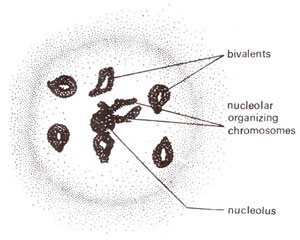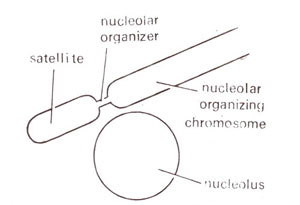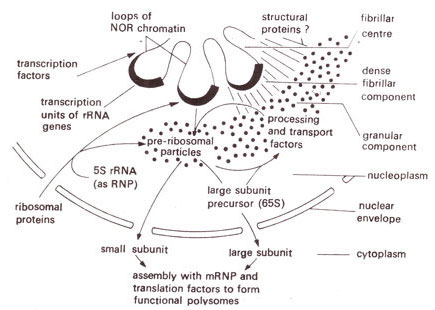Nucleolus

Fig. 6.5. A diakinesis cell showing attachment of a bivalent with nucleolus.

Fig. 6.6. A satellited chromosome and an attached nucleolus.

Fig. 6.7. Three regions of the nucleolus showing their roles in ribosomal RNA (rRNA) synthesis.

Fig. 6.5. A diakinesis cell showing attachment of a bivalent with nucleolus.

Fig. 6.6. A satellited chromosome and an attached nucleolus.
During meiosis as well as during mitosis, the nucleolus disappears during prophase. It reappears again during telophase and is associated with the same known nucleolar organizing chromosome (consult Physical Basis of Heredity 2. Cell Division (Mitosis and Meiosis)). Quite often, more than one nucleoli in the same nucleus may also be observed. These several nucleoli may subsequently coalesce and give rise to larger single nucleolus.
While chromatin mainly consists of DNA, nucleolus mainly consists of RNA, acidic dyes and basic dyes; phospholipids and alkaline phosphatase are also found. Nucleolar DNA had also been reported in a number of cases. This DNA is believed to represent the nucleolar organizer.
The initiation, production and maturation of ribosomes in the nucleolus seem to proceed from centre to the periphery in the following three distinct regions : (i) Fibrillar centre, where rRNA genes of NOR (nucleolar organizing region) are located; the transcription of rRNA genes (RNA synthesis on DNA template) also takes place in this region, (ii) Fibrillar component, which surrounds the fibrillar centre and where RNA synthesis progresses. The 80s ribosomal proteins (rps) also bind to the transcripts in this region, (iii) Cortical granular component, which is the outermost region and where processing and maturation of pre-ribosomal particles occurs. These three regions of the nucleolus and their roles in ribosome formation are shown in Figure 6.7.




